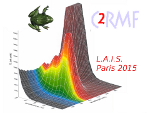Jastrzebnik Cave is situated in the limestone rock located in the southern part of the Krakow-Czestochowa Upland (Poland). It is one of the most interesting Palaeolithic settlements in the region (Cyrek, 2009) and the stratigraphic sequence encompasses middle and upper Pleistocene sediments.
Four sediment samples were selected for luminescence dating. The OSL method, applying the single aliquots regenerative (SAR) dose protocol (Murray and Wintle, 2000) was used. The Riso reader, model TL/OSL-DA-20 (Bøtter-Jensen et al., 2010) equipped with blue LED light source for stimulation was used for OSL measurements. The newly established equivalent bleaching method (Przegiętka and Chruścińska, 2013)) was applied for estimation of equivalent dose. The extended preheat tests were performed in order to choose optimal temperature value for OSL readouts (Kijek et al., 2013). The annual dose rates comprised of beta and gamma radiations, were calculated on the base of gamma spectra measured in laboratory with help of gamma spectrometry (Oczkowski and Przegietka, 1998). The radon 222Rn escape was observed for some samples and this effect is investigated in details.
The luminescence chronology supports archaeological and geological research approaching the cave as a complex archaeo-environmental study. The results of sedimentological, geomorphological, palaeozoological and archaeological investigations accompanied by OSL ages provided the basis for the reconstruction of the history of habitation at the Jastrzebnik Cave, in the background of palaeoenvironmenal transformations.
- Poster

 PDF version
PDF version

